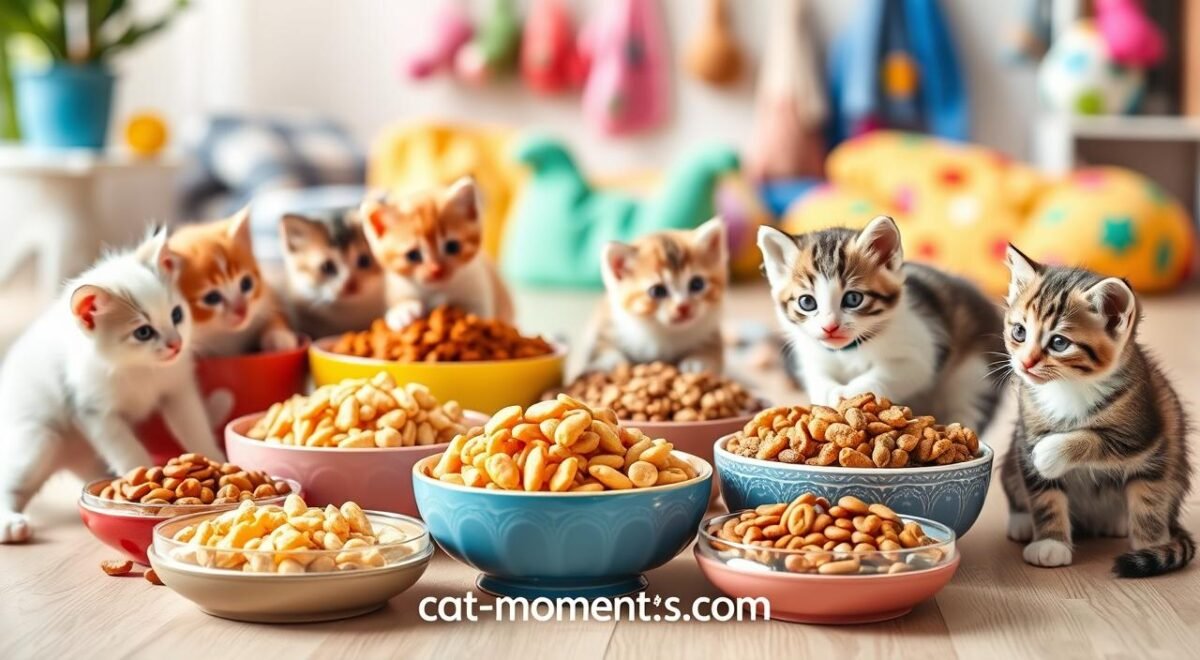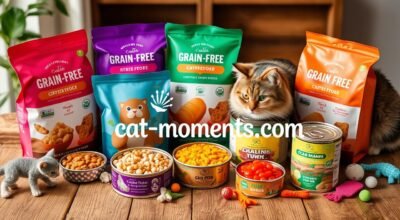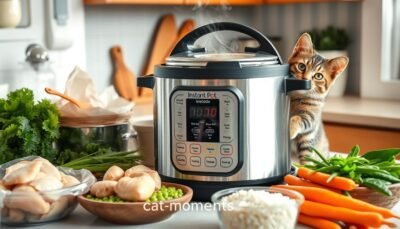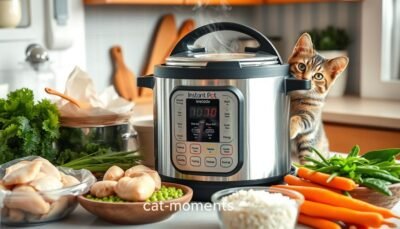Raising a kitten is exciting and rewarding. But, it also means making sure they get the right food. As a new cat parent, you might wonder what the best kitten food is. This guide will help you choose the right one for your pet’s growth.
What nutrients and ingredients should be in your kitten’s food? How do you pick between wet and dry food? Which brands are known for quality? Let’s explore kitten nutrition and find the best start for your kitten.
Key Takeaways
- Kittens need special nutrients like high-quality protein and essential vitamins. These are different from what adult cats need.
- Wet and dry food together can give kittens a balanced diet. Wet food is tasty and easy to digest.
- Brands like Purina, Fancy Feast, Hill’s Science Diet, and Royal Canin offer many options. They meet different kitten needs.
- When choosing kitten food, look at AAFCO standards, ingredient quality, and price. These factors are important.
- Feeding your kitten the right amount at the right time is key for their growth and health.
Understanding Your Kitten’s Nutritional Needs
As a new cat parent, it’s key to know what your kitten needs to eat. Kittens grow fast and need a special diet to support their growth. A balanced kitten diet is important for their health and happiness.
Essential Nutrients for Growing Kittens
Kittens need over 30 important nutrients, like proteins, fats, vitamins, and minerals. Proteins and amino acids are especially important. They should make up 35-50% of the kitten food.
The Role of Proteins and Fats
Proteins help build a kitten’s muscles and organs. Fats are a main energy source and keep their skin and coat healthy. The fat content in kitten food should be 18-35%.
Important Vitamins and Minerals
- Calcium and phosphorus are key for strong bones and teeth.
- Vitamins A, E, and zinc boost their immune system.
- DHA, an omega-3 fatty acid, helps with brain development.
- Taurine is vital for growth and development.
It’s crucial to make sure your kitten gets these nutrients for their health.
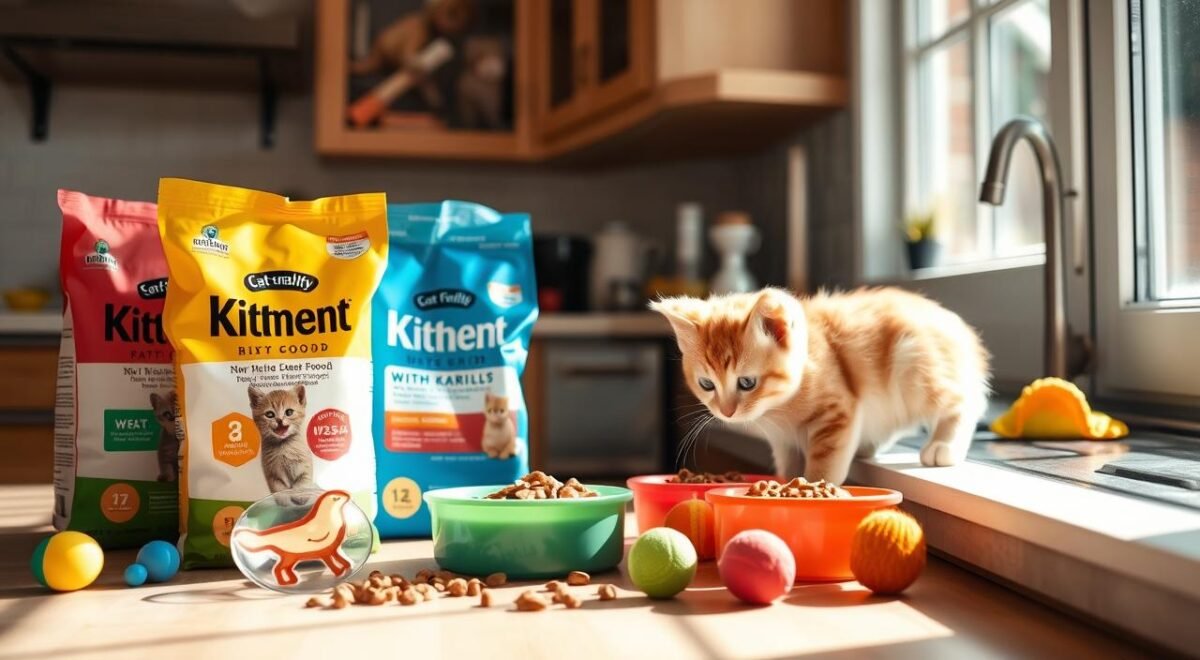
“Kittens require a diet that is specially formulated to support their rapid development and explosive growth.”
Wet vs. Dry Kitten Food: Making the Right Choice
Choosing between wet and dry kitten food is a big decision for new cat parents. Each option has its benefits, but knowing your kitten’s needs is key.
Wet kitten food has a lot of moisture, about 75-78%. This is great for kittens because it helps them stay hydrated and keeps their kidneys healthy. Dry kitten food, on the other hand, has only 10-12% moisture. It’s easier to store and less expensive.
Dry kitten food is good for your kitten’s teeth because it helps remove plaque. But, kittens might get used to eating the same thing all the time. This could make them less interested in trying new foods.
| Wet Kitten Food | Dry Kitten Food |
|---|---|
| Higher moisture content (75-78%) | Lower moisture content (10-12%) |
| Promotes hydration and kidney health | Supports dental health by scraping plaque |
| May be more expensive | More cost-effective |
| Kittens may prefer a single texture | Kittens may develop a preference for one texture |
Vets often suggest mixing wet and dry kitten food for a balanced diet. This way, your kitten gets all the nutrients, water, and dental care they need to grow strong.
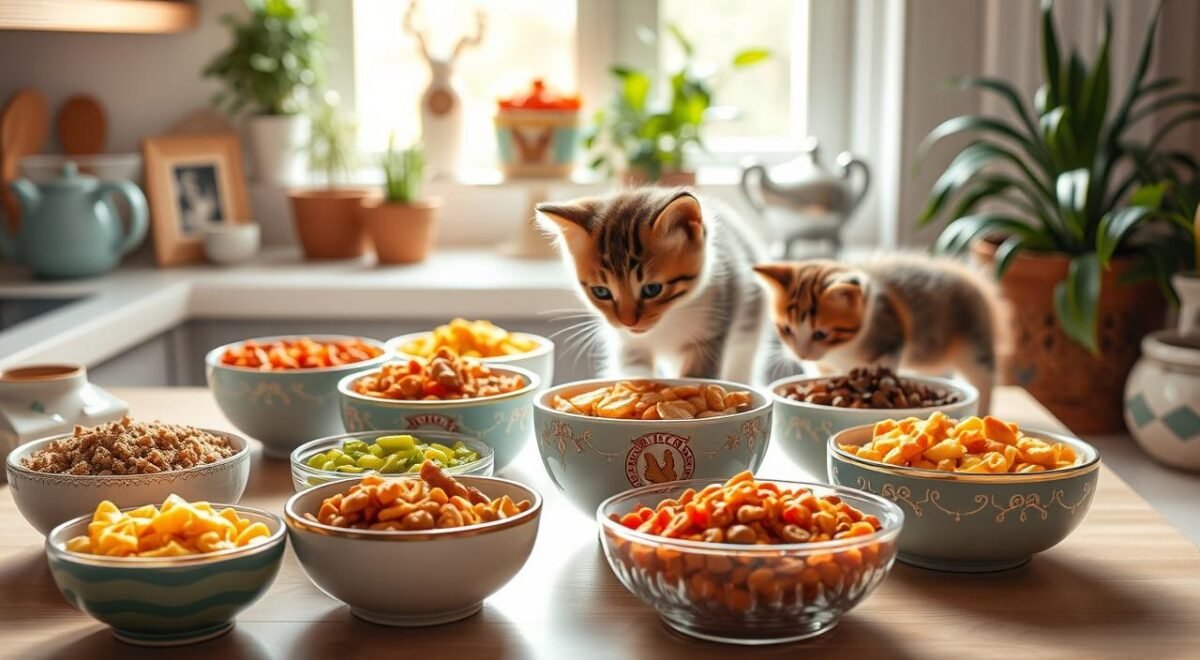
“Providing a mix of wet and dry kitten food can help ensure your feline friend receives a well-rounded and nutritious diet.”
The decision between wet and dry kitten food depends on your kitten’s taste, your budget, and their health. Knowing the good and bad of each can help you choose the best for your kitten’s health and happiness.
Top-Rated Kitten Food Brands in 2025
We all want the best for our pets, especially their food. The kitten food market has many choices, each claiming to be the best. Let’s look at some top-rated kitten food brands for 2025.
Premium Brand Options
Pet owners looking for the best ingredients and formulas should check out Purina Pro Plan, Fancy Feast, and Hill’s Science Diet. These brands use natural ingredients and test their food to ensure it’s good for kittens.
Budget-Friendly Choices
Not everyone can spend a lot on pet food. Luckily, there are affordable options that still offer good nutrition. Iams Perfect Portions and Natural Balance are great choices for those on a budget.
Veterinarian-Recommended Selections
Vets are the best for pet health advice. It’s smart to choose kitten food brands they recommend. Royal Canin and Wellness are often recommended for their focus on feline nutrition.
| Brand | Protein Content | Fat Content | Fiber Content | Moisture Content |
|---|---|---|---|---|
| Purina Pro Plan | 42% | 20% | 3% | 78% |
| Fancy Feast | 11% | 5% | 1% | 82% |
| Hill’s Science Diet | 35% | 18% | 4% | 75% |
| Royal Canin | 38% | 19% | 3% | 77% |
| Iams Perfect Portions | 30% | 16% | 5% | 78% |
| Natural Balance | 34% | 17% | 4% | 78% |
Choosing the right food for your kitten is crucial. Always talk to your vet to find the best food for your kitten’s needs. With so many great brands out there, you’ll find the perfect kitten food for your kitten.
AAFCO Standards and Quality Indicators
Choosing the right cat nutrition and kitten diet is key. Knowing the AAFCO (Association of American Feed Control Officials) standards is important. AAFCO ensures pet foods are complete and balanced for all life stages.
Check for labels saying “complete and balanced for growth” or “all life stages.” This means the food meets AAFCO’s strict standards. Good cat nutrition and kitten diet brands list meat first. They also have enough protein (at least 30%) and fat (at least 9%) in the food.
Top pet food makers do lots of quality checks. They use experts in veterinary nutrition to make sure their food meets AAFCO’s rules. This means your kitten gets the best, most nutritious food.
| AAFCO Nutrient Requirements | Growth/Reproduction | Adult Maintenance |
|---|---|---|
| Protein | Minimum 30% | Minimum 26% |
| Fat | Minimum 9% | Minimum 9% |
Learning about AAFCO’s quality standards helps you pick the best kitten diet. This ensures your kitten grows strong and healthy.
Understanding Kitten Food Labels and Ingredients
Starting out as a cat parent can feel overwhelming. But, learning about kitten food labels and ingredients is key. It helps you choose the best and for your kitten. Let’s explore what’s important.
Common Ingredients to Look For
- High-quality protein sources, such as chicken, turkey, or fish
- Fish oil for essential fatty acids, including DHA, which supports brain and eye development
- Prebiotics and probiotics to promote digestive health
Ingredients to Avoid
- Artificial preservatives, colors, and flavors
- Fillers like corn, wheat, or soy, which can be difficult for kittens to digest
- By-products or unnamed meat sources
Decoding Nutritional Information
The guaranteed analysis on the label gives you key info about the . It shows the minimum percentages of protein and fat. It also shows the maximum percentages of fiber and moisture. Ingredients are listed in order of weight, so the first ones are the most important.
| Nutrient | Dry Food (Food A) | Canned Food (Food B) |
|---|---|---|
| Protein | 33.4% (dry matter basis) | 35.1% (dry matter basis) |
| Fat | 21.8% (dry matter basis) | 21.8% (dry matter basis) |
| Carbohydrates | 37.1% (dry matter basis) | 26.2% (dry matter basis) |
By understanding label details and comparing options, you can pick the best for your kitten. This ensures they get the they need to grow and thrive.
Choosing the Best Kitten Food for Different Life Stages
Choosing the right kitten food is key for your kitten’s growth. Kitten formulas meet their special nutritional needs at every stage. Knowing what each stage needs helps you pick the best food for your kitten.
Newborn kittens need lots of protein and fats for growth. Their food should have more than 50% protein and up to 20% fat. As they grow, they need more calories, about 60 per 450 grams of body weight until they’re a year old.
- Kittens grow about 10 grams a day in the early stages.
- Wet kitten food has about 70% moisture, while dry food has up to 10%.
- Important nutrients like vitamins A, D, E, K, B12, and minerals like calcium, phosphorus, and potassium are vital for kittens.
As your kitten grows, their diet might need to change. Some foods are made for different ages within the kitten stage. When it’s time to switch to adult food, do it slowly to prevent upset stomachs.
Understanding kittens’ dietary needs at each stage ensures they get the best nutrition. Talk to your vet to find the best kitten diet and cat nutrition plan for your kitten.
Special Dietary Considerations and Sensitivities
Kittens usually do well on a balanced diet. But, some might need special food because of health issues or allergies. These diets meet their specific needs, ensuring they grow and develop well.
Grain-Free Options
Some kittens do better without grains in their kitten food. Grains can cause allergies or upset their stomachs. Grain-free pet supplies use other carbs like potatoes or legumes, avoiding these problems.
Hypoallergenic Formulas
Kittens with food allergies might benefit from hypoallergenic kitten food. These formulas use new proteins like venison or duck. This helps avoid allergic reactions and can solve skin and digestive issues.
Limited Ingredient Diets
Limited ingredient kitten food has fewer ingredients. It focuses on one protein and a few carbs. This is good for kittens with sensitivities, as it’s easier to find and avoid allergens.
Always talk to your vet before changing your kitten’s diet. They can figure out what’s causing the problem and suggest the best pet supplies for your kitten.
Conclusion
Choosing the right kitten food is key for your kitten’s growth. Knowing their nutritional needs and picking top cat nutrition brands is important. This ensures your kitten stays healthy and happy.
High-quality wet and dry pet supplies from trusted sources are vital. Your vet’s advice can help tailor the diet for your kitten. This way, your kitten will live a long, healthy life.
It’s important to pick the right kitten food and watch portion sizes. Also, switching to adult cat food at the right time is crucial. With so many options, finding the best food for your kitten is easy.
Your kitten’s health should always come first when choosing their food. Stay informed, get expert advice, and adjust to your kitten’s needs. This way, you’ll give them the best nutrition for a happy, healthy life.
FAQ
What are the essential nutrients for a growing kitten?
Kittens need a diet rich in protein, with meat as the main ingredient. They also need DHA for brain growth, calcium and phosphorus for strong bones, and taurine for overall health. The best foods include fish oil for omega-3s, vitamins A, E, and zinc for immune health, and prebiotics and probiotics for a healthy gut.
How do wet and dry kitten foods differ in terms of nutrition and benefits?
Vets say kittens should eat both wet and dry food every day. Wet food helps keep them hydrated, while dry food is good for their teeth. Wet food has more moisture than dry, which is better for cats’ natural water intake. However, dry food is easier to store and more affordable, but it should be mixed with other foods to keep things interesting.
What are the top-rated kitten food brands to consider?
Top brands include Purina Pro Plan, Fancy Feast, and Hill’s Science Diet. Royal Canin, Iams, Wellness, Blue Buffalo, and Merrick are also great. Premium brands use better ingredients and have special formulas. Budget-friendly options like Iams Perfect Portions and Natural Balance offer good nutrition at lower prices. Brands recommended by vets often go through feeding trials and use nutrition experts.
What should I look for on a kitten food label to ensure it meets my kitten’s needs?
Look for labels that say “complete and balanced for growth” or “all life stages.” This means the food meets AAFCO standards. Good labels list meat first, have enough protein (at least 30%) and fat (at least 9%) on a dry matter basis. Reputable brands test their food and use nutrition experts.
When should I transition my kitten to adult cat food?
Kittens should eat kitten food until they’re about 1 year old. Different formulas are for different ages, from newborn to young adult. Switching to adult food should be slow to avoid upset stomachs.
Are there any special dietary considerations for kittens with sensitivities or health issues?
Kittens with sensitivities or health problems might need special diets. Grain-free foods are good for those with grain allergies. Hypoallergenic formulas use new protein sources to avoid allergies. Limited ingredient diets can help find and avoid allergens. Always talk to a vet before changing your kitten’s diet.
Source Links
- https://www.nbcnews.com/select/shopping/best-kitten-food-rcna151329 – Yes, there is a difference between cat food and kitten food. Here’s why it matters.
- https://bestfriends.org/pet-care-resources/bottle-feeding-kittens-comprehensive-guide – Bottle-Feeding Kittens: A Comprehensive Guide
- https://bowwowinsurance.com.au/pet-community/pet-talk/different-diets-for-kittens/ – What to Feed Kittens: Nutrition & Feeding Guide for Kittens
- https://www.petfoodinstitute.org/a-to-z-of-pet-food-kitten-nutrition/ – A to Z of Pet Food: Kitten Nutrition – Pet Food Institute
- https://vcahospitals.com/know-your-pet/feeding-growing-kittens – Feeding Growing Kittens | VCA Animal Hospitals
- https://www.webmd.com/pets/cats/features/feeding-your-kitten-food-and-treats – Feeding Your Kitten: Kitten Food and Treats Basics
- https://www.petmd.com/cat/nutrition/wet-cat-food-vs-dry-cat-food-which-better – Wet Cat Food vs. Dry Cat Food: Which Is Better?
- https://homeatlastrescue.ca/wet-vs-dry-food/ – Wet vs Dry Food for Your Kitten or Cat | Home At Last Rescue
- https://bondvet.com/b/wet-or-dry-cat-food-which-one-is-best-for-your-cat – Wet or Dry Cat Food: Which One Is Best for Your Cat? | Bond Vet
- https://www.petmd.com/cat/vet-verified/best-cat-food – The 11 Best Cat Foods in 2024, Recommended By Vets
- https://www.nbcnews.com/select/shopping/best-cat-food-ncna1235804 – Should cats eat wet food, dry food or both? Vets weigh the pros and cons
- https://truthaboutpetfood.com/the-list/ – The List
- https://www.petmd.com/dog/nutrition/What-Is-AAFCO-and-What-Does-It-Do – What Is AAFCO and What Does It Do?
- https://www.aafco.org/consumers/understanding-pet-food/reading-labels/ – Reading Labels – AAFCO
- https://veterinarypartner.vin.com/default.aspx?pid=19239&id=8808771 – AAFCO Pet Food Labeling
- https://www.petmd.com/cat/slideshows/nutrition-center/determining-best-cat-food-ingredients-label – How to Read a Cat Food Label
- https://www.webmd.com/pets/cats/features/how-to-read-cat-food-labels – How to Read Cat Food Labels
- https://vcahospitals.com/know-your-pet/deciphering-cat-food-labels – Deciphering Cat Food Labels | VCA Animal Hospitals
- https://untamed.com/blogs/nutrition/kitten-food – Tips and tricks for choosing the best kitten food
- https://www.petbarn.com.au/petspot/kitten/food-and-nutrition-kitten/choosing-the-best-kitten-food/?srsltid=AfmBOoo8P19COli7_uqDjkPBvw4z1YyZMsX4UWUhl2ja8MWfdMV8ogHl – Choosing the Best Kitten Food: Top Nutrition Tips | Petbarn
- https://www.blueoasispethospital.com/services/cats/feline-nutrition-cat-food – Cat Nutrition – What You Need To Know About Your Cat’s Nutrition
- https://vcahospitals.com/know-your-pet/nutrition-feeding-guidelines-for-cats – Nutrition – General Feeding Guidelines for Cats | VCA Animal Hospitals
- https://www.beltonvetclinic.com/services/cats/feline-nutrition-cat-food – Optimum Feline Nutrition – What Should You Feed Your Cat?
- https://www.catsluvus.com/cat-grooming/kitten-food/ – Expert Tips On Choosing The Best Kitten Food For Your New Feline – Cat Boarding Hotel Laguna, Mission Viejo, Anaheim, Santa Ana, CA | Cats Luv Us
- https://vethelpdirect.com/vetblog/2022/05/09/why-should-i-feed-a-kitten-a-special-diet/ – Why should I feed a kitten a special diet? – Vet Help Direct
- https://pangovet.com/pet-nutrition/cats/kitten-food-vs-cat-food/ – Kitten Food vs Cat Food: The Key Differences, Pros & Cons | PangoVet
